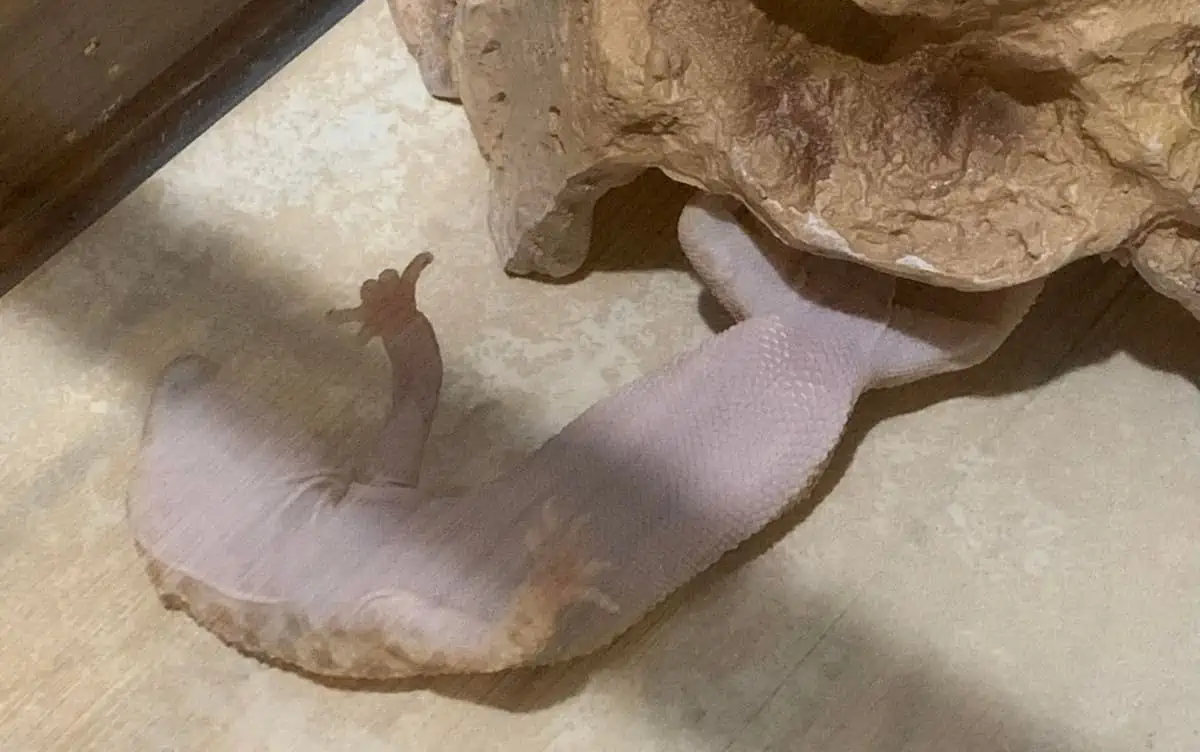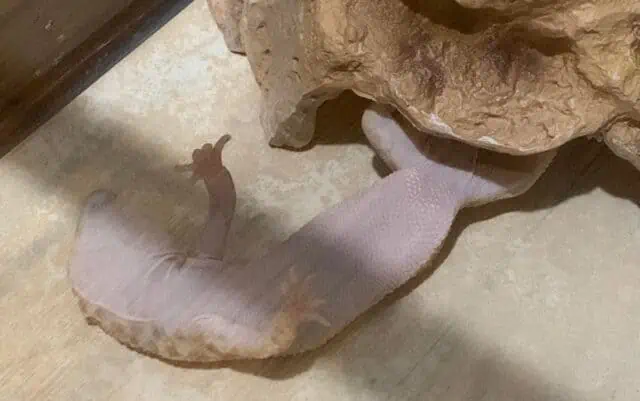When a leopard gecko is upside down, it usually implies a serious health concern, typically related to a neurological condition known as enigma syndrome. This syndrome affects the gecko’s sense of balance and physical position, often causing them to flip over unintentionally. This condition can be distressing both for the gecko and its owner, as it disrupts the normal behaviors and activities of the leopard gecko.
Enigma Syndrome Behaviors: Leopard geckos with Enigma syndrome exhibit distinct behaviors like tremors, seizures, star gazing, and circling. Observing these behaviors can help identify affected geckos.
Lifespan Consideration: The lifespan of a gecko with Enigma syndrome varies based on the severity of their condition. Mild cases may see lifespans up to 20 years, while most affected geckos live less than 10 years.
Managing Symptoms: If you observe your leopard gecko flipping upside-down or exhibiting other symptoms, handle them gently. Chilling live food can also aid geckos with poor catching ability due to the syndrome.
Unusual Hiding Habits: Affected geckos might hide in unexpected places or explore typically avoided areas, signaling the syndrome’s influence on their cognitive abilities.
Seek Expert Guidance: If your gecko displays multiple symptoms, it’s crucial to consult with a veterinarian experienced with reptiles for proper diagnosis and care guidance.
Why is My Leopard Gecko Upside Down?
When your leopard gecko is found upside down, it’s a genuine cause for concern. One of the main reasons for this unusual behavior is a neurological condition termed as Enigma syndrome. Enigma syndrome significantly affects leopard geckos by disrupting their balance and physical position sense, which leads them to constantly find themselves flipped over.
Enigma syndrome is deeply troubling because it hinders the gecko’s ability to orient themselves properly. It alters their neurological functioning, making normal movements and behaviors a struggle. These geckos will often struggle to right themselves, which can be distressing to watch.
This condition is more than just a mere inconvenience; it’s a serious ailment that requires attention and understanding. Addressing this issue promptly is crucial, as it impacts the gecko’s quality of life. The sooner the symptoms are recognized, the quicker appropriate measures can be taken to manage the condition and ensure the well-being of the gecko.
What To Do If You Find Him Flipped Over
Discovering your leopard gecko flipped over can be alarming. It’s essential to act with care and attentiveness. Here’s a step-by-step guide on what to do in such situations:
- Approach the gecko gently, avoiding any sudden movements that might stress him out more.
- Talk softly or maintain silence, as geckos can get scared of loud noises.
- Gently turn the gecko right-side up using soft, smooth materials like a piece of cloth or tissue to avoid injuring him.
- Once right-side up, carefully observe him for any signs of injury or distress. Look for any cuts, bruises, or abnormalities.
- If the gecko shows signs of distress, like rapid breathing or limping, it’s crucial to keep him in a quiet, secure environment to reduce stress.
- Continuously monitor the gecko for any lingering signs of distress or injury after flipping him over.
Other Signs of the Enigma Syndrome
Enigma Syndrome manifests in leopard geckos through a range of signs beyond just causing them to flip upside down. Each symptom reflects the internal struggle the gecko faces due to this condition. These signs can be subtle or pronounced.
Tremors
Tremors are a concerning phenomenon in leopard geckos affected by Enigma syndrome. These involuntary shakes and vibrations are indicative of loss of muscle function in their brain cells. This malfunction leads to their struggling bodies, vibrating as they experience difficulty stabilizing themselves, which is agonizing to witness.
The root of these tremors is not only the loss of muscle function but also the overall neurological damage caused by Enigma syndrome. The brain cells controlling muscle function are compromised, disrupting the regular, stable movement of the gecko.
Seizures
Seizures are a stark and painful reality for leopard geckos grappling with Enigma syndrome. They are characterized by sudden, uncontrollable electrical disturbances in the brain, manifesting through erratic movements, loss of consciousness, or abnormal behavior. The causes are deeply rooted in the neurological impairments induced by Enigma syndrome, turning the gecko’s world into a tumultuous storm of pain and confusion.
Seizures represent the most fatal outcome of Enigma syndrome, bringing along excruciating pain and limb numbness, stripping away the lively essence of affected geckos. This condition can be severely distressing, both for the gecko and the owner, witnessing such intense suffering.
Repetitive Motions
Leopard geckos afflicted with Enigma syndrome often exhibit a range of repetitive motions, a distressing signal of their internal turmoil. These include circling, head tilting, and relentless movements of the tail or head. Each of these repetitive behaviors is like a whisper of the gecko’s internal struggle, painting a picture of their altered reality.
These constant, involuntary actions significantly impact the gecko’s daily behavior, altering their interactions with their environment and their general way of life. For instance, the constant circling or relentless head movements can inhibit their ability to explore, rest, or even eat properly, highlighting the profound effect Enigma syndrome has on their quality of life.
Star Gazing
Star gazing is another behavior exhibited by leopard geckos affected by Enigma syndrome, and it is as mysterious as it sounds. It refers to the act of a gecko staring intently in one direction for extended periods, seemingly unresponsive to the external environment or stimuli. It’s as if they’re lost in their own world, trapped in a state of profound contemplation.
This peculiar leopard gecko behavior is believed to be a coping mechanism, a way for them to stabilize themselves in their disjointed reality. It is analogous to how we humans focus on a fixed object to alleviate motion sickness, to find a point of stability in a sea of chaos.
Head Tilting
Head tilting in leopard geckos is a behavior that manifests as an evident inclination of the head to one side, a silent testament to their internal discomfort. This seemingly innocuous action is much more than a quirky posture—it’s a signal, a subtle whisper of the troubles brewing within.
Head tilting could be indicative of several underlying issues such as a loss of balance, usually stemming from neurological disruptions caused by conditions like Enigma syndrome. But it isn’t limited to just that; it could also be a sign of an ear infection, where the tilting helps alleviate discomfort or pressure, or it could point to malnutrition, a reflection of their body’s struggle in the absence of essential nutrients.
Circling
Circling is another distinctive behavior observed in leopard geckos, especially those grappling with Enigma syndrome. This syndrome can commandeer their natural behaviors, turning them into shadows of their vibrant selves, their bodies tracing circles in their enclosures as they seemingly attempt to chase their tails. It’s a dance of distress, a manifestation of their internal turmoil.
When a leopard gecko is circling, it’s not engaging in playful antics; it’s displaying a symptom of a deeper issue. It could be due to the neurological impacts of Enigma syndrome, skewing their perception and compelling them to move in perpetual circles.
Poor Catching Ability
Leopard geckos affected by Enigma syndrome often struggle with poor catching ability. This condition wreaks havoc on their innate skills, rendering them unable to efficiently catch their prey, a skill fundamental to their survival in the wild. Enigma syndrome distorts their world, leaving them disoriented and their fine motor skills eroded, a combination that diminishes their ability to catch food.
Disorientation and a loss of fine motor skills are the culprits behind the reduced catching ability. They compromise the gecko’s precision and timing, making the act of catching live prey an uphill task. The geckos find themselves in a relentless struggle, their bodies unable to synchronize with their instincts.
Given these challenges, it becomes essential to facilitate their feeding process. Chilling live food can slow down the prey, providing the gecko with a better chance of successfully catching its meal.
Hiding Habits
When a leopard gecko affected by Enigma syndrome displays unusual hiding habits, it’s a sign of the turmoil within. This syndrome can force geckos to retreat to strange, unconventional hiding spots, abandoning the security of their usual refuges. They might explore corners and crannies of their habitat they’d normally avoid, revealing a stark change in their behavioral patterns.
The syndrome’s interference with their cognitive and decision-making abilities is responsible for these peculiar hiding tendencies. It’s as if their mental compass has been disrupted, steering them towards atypical and potentially unsafe havens. The once discerning creatures now seem to lose their way, making erratic and unusual choices about where to seek shelter and solace.
How Long Do Geckos with Enigma Syndrome Live?
The lifespan of geckos grappling with Enigma syndrome is a spectrum, significantly influenced by the severity of their condition. For those enduring milder manifestations of the syndrome, life can extend up to around 20 years, allowing them a substantial period to explore and experience their environment.
However, geckos suffering from more severe or generalized forms of Enigma syndrome are not as fortunate. Their existence is often cut short, typically enduring for less than 10 years. The myriad of health issues and complications associated with this condition can expedite their decline, reducing their ability to thrive and survive in their habitats.
PS: If you want to learn more about possible conditions of the Leo, I’ve recently written about problematic skin shedding and about reasons why this shedding process might not take place.






